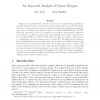Free Online Productivity Tools
i2Speak
i2Symbol
i2OCR
iTex2Img
iWeb2Print
iWeb2Shot
i2Type
iPdf2Split
iPdf2Merge
i2Bopomofo
i2Arabic
i2Style
i2Image
i2PDF
iLatex2Rtf
Sci2ools
CC
2007
Springer
2007
Springer
An Improved Analysis of Linear Mergers
Mergers are procedures that, with the aid of a short random string, transform k (possibly dependent) random sources into a single random source, in a way that ensures that if one of the input sources has min-entropy rate δ then the output has min-entropy rate close to δ. Mergers were first introduced by Ta-Shma [28th STOC, pp. 276-285, 1996] and have proven to be a very useful tool in explicit constructions of extractors and condensers. In this work we present a new analysis of the merger construction of Lu et al [35th STOC, pp. 602-611, 2003]. We prove that the merger’s output is close to a distribution with min-entropy rate of at least 6 11 δ. We show that the distance from this distribution is polynomially related to the number of additional random bits that were used by the merger (i.e its seed). We are also able to prove a bound of 4 7 δ on the min-entropy rate at the cost of increasing the statistical error. Both results are improvements to the previous known lower bound ...
| Added | 12 Dec 2010 |
| Updated | 12 Dec 2010 |
| Type | Journal |
| Year | 2007 |
| Where | CC |
| Authors | Zeev Dvir, Amir Shpilka |
Comments (0)

